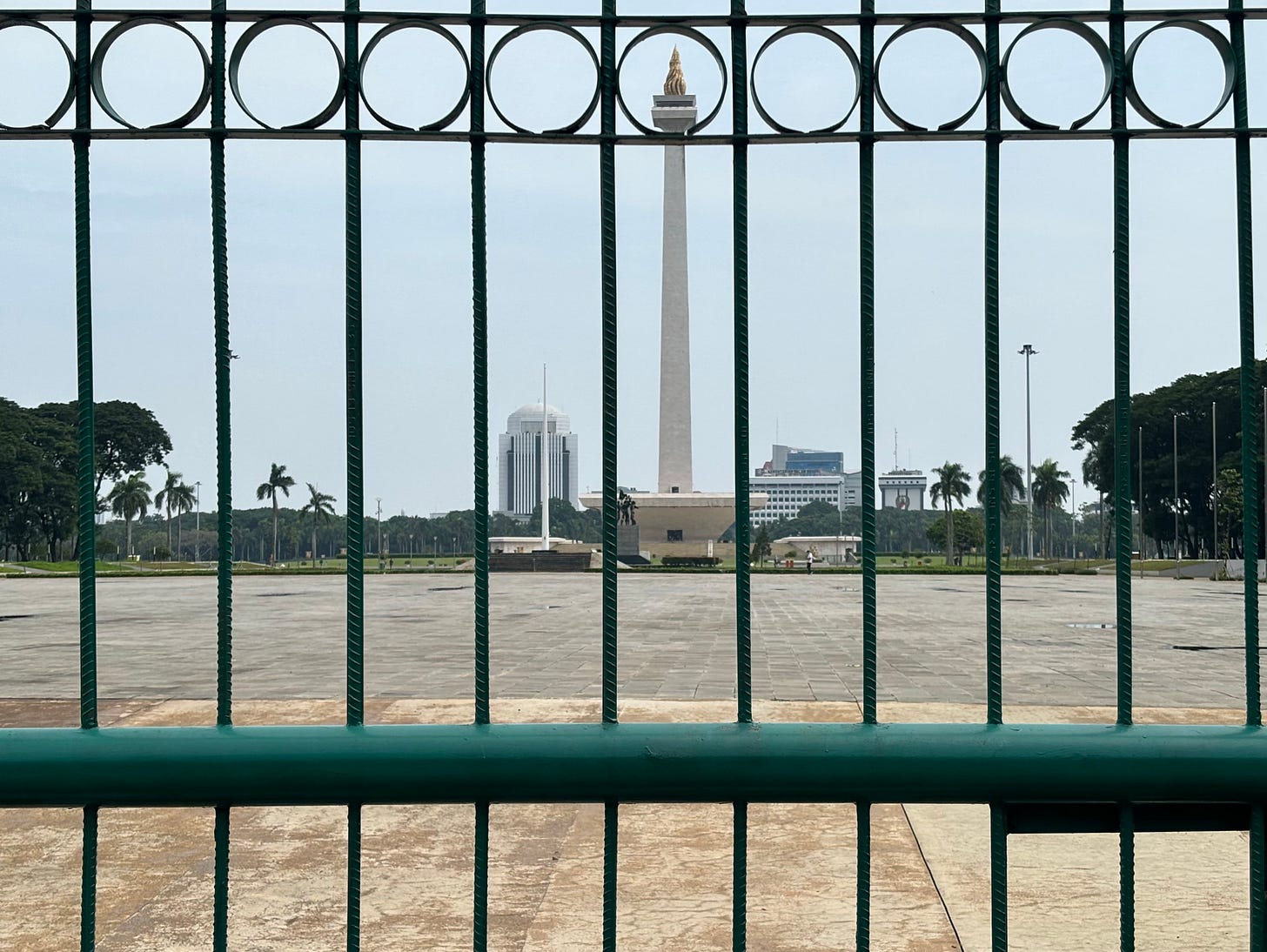Lie-flat (almost) across Indonesia
A trip by train across the island of Java. Plus: Crossing paths with Amelia Earhart in Surabaya.
Flying in Business Class is expensive. But if you want a premium travel experience, it costs a lot less on a train.
Trains in many countries have long offered sleeping cars — often called “sleepers” — where travelers get to enjoy beds in cozy compartments. Sometimes just one bed, sometimes two or more. Ocasionally with a private bathroom. I suppose that is the train equivalent of a First Class Suite on an Emirates A380. Minus the Dom Perignon and caviar.
I’m a big fan of sleepers. I’ve traveled in them in Europe, India, and elsewhere. Once I traveled from Moscow to Beijing by sleeper train with my then nine-year-old daughter. And later from Santa Barbara to New York with my then 12-year-old son.
Some people consider sleeping cars on trains to be roughing it. However, I always remind myself what it would cost if one was traveling like this on a plane.
But much less common are airline-style, lie-flat sleeping pods. In other words, a train equivalent of modern airline long-haul Business Class. The best you can normally hope for on a train if you aren’t in a sleeping car is a decent recliner — something a bit like domestic First Class or international Premium Economy on a plane.
But recently, I came pretty close to enjoying the full Business Class seating experience on a train. It happened in Indonesia.
Making it to Indonesia
My son — a college sophomore — and I made a short trip to Indonesia over his spring break. It was meant to be a visit to a former Dutch colony immediately after running a half marathon in Holland — just like we had gone to Mozambique, a former Portuguese colony, a year earlier right after running one in Lisbon. But, as narrated in another post, the standby travel gods prevented us from making it to Holland and we ended up doing a last-minute 10K in Dubai instead. Although missing Holland stripped the trip of its geo-historical symmetry, we pressed on to Indonesia regardless.
The day after the race, we flew on Emirates from Dubai to Jakarta (not lying flat). And the plan was to take a series of three trains across the island of Java, the most populous of the Indonesian islands and the home to the country’s capital.
Train 1: The Jakarta airport train
The first train was only from the airport to the city center. But the Rail Link, as it is known, is worth mentioning, as it is an excellent local train that provides a good introduction to the country’s really outstanding rail system.
The Rail Link takes you through the outskirts of this huge metropolis skirting a variety of neighborhoods, including some shanty town areas visitors would otherwise rarely get to see, before taking you into the city center.




Jakarta arrival
We were in Jakarta for two nights. We stayed at the Mandarin Oriental, a short walk from where we exited the Rail Link, and a long way in spirit from some of the nearby neighborhoods we had just seen from the train. I wouldn’t normally have stayed in such a fancy hotel on a trip like this (I’m generally more of a three-star guy these days). But Jakarta is one of the least expensive major cities in the world. The Mandarin cost us only $140 a night, not much more than some places a lot less nice.
I recall staying at the original Mandarin Oriental in Hong Kong many years ago, before it spread its geographical wings. In some ways, it — and the Peninsula in Kowloon across the Hong Kong Bay — were the trailblazers of today’s genre of luxury hotels in East and South East Asia. Candidly, the Jakarta property was not quite on a par in detail with other Mandarin Orientals at which I have stayed, the Hong Kong one, as best as I can remember it, and those in London, Munich, and San Francisco. But it was good enough by far. And the outstanding staff more than made up for any cutbacks from the original formula.
We checked in on the eve of Ramadan. Indonesia is not a dry country. But it is a mostly Moslem nation. And we were informed that an order had gone out that all hotel bars were to close that night and the following one. Fortunately, right across the road was the Skye Bar at the top of a 56-floor tower, which for some reason was not subject to the Ramadan order — and it, with its outdoor terrace, proved quite the happening place. The Mandarin even gave us buy-one-get-one-free coupons.
Walking in Jakarta
Most visitors to Indonesia don’t linger in Jakarta. But the city of over 11 million people is well worth a day or two. Forget about formal sight seeing. The “sights” on any guided tour really are not all that interesting. It’s more a matter of wandering the city to get feel for it and viewing life on the streets rather than spending time behind the doors of monuments or museums.
On the plane from Dubai, I worked out a rough walking itinerary — which included a number of “sights” as waypoints rather than destinations — and we ended up covering around 12 miles on foot in the sweltering heat the day after we arrived.
Jakarta is not a classically walker-friendly city, to put it mildly. In fact, walking in the city is a bit of an adventure when it comes to dodging traffic. But the hair-raising moments are rewarded by a constant stream of interesting urban detail.
At one point, a bunch of kids — I wondered if they were a local street gang — dove into fierce traffic to stop it to allow us to cross as we were stuck on a center divider with buses and trucks barreling down on each side. I was fully expecting the kids who stopped the traffic to demand money. That is the way of the world. But they didn’t. I might have given them something anyway, but it all happened too quickly.
This is typical of Jakarta — there is virtually no hustling. Just about no one tries to separate tourists from their money in any sort of agressive or sketchy manner. Perhaps one of the reasons is there isn’t much of a tourist industry in the city. If your business model is to rip off tourists, you probably wouldn’t have enough of a market to make it worthwhile. This makes Jakarta a curiously chill city to visit, amidst the moderate chaos on the street.
I wouldn’t say central Jakarta is awash with agreeable places to stop for lunch once you get away from where most hotels are located. But a notable exception is the very atmospheric and stylish Café Batavia toward the north in the old Dutch colonial portion of the city — which is also by far the most pedestrian-friendly part of town. Though styled as a “café,” the Batavia is really more of a restaurant. It’s well worth a visit if you want to imagine yourself in the Jakarta of many years ago. We enjoyed some nasi goreng, the traditional Indonesian fried rice dish. Like the Skye Bar, the Batavia didn’t seem to be on the distribution list of the authorities’ Ramadan memo. So we washed down our lunch with some locally brewed Bintang beer.


Jakarta’s existentialist issues
Jakarta faces some existentialist issues. As a consequence of excessive groundwater extraction, rapid urbanization, and rising sea levels due to climate change, 40 percent of the city is currently below sea level. Parts are sinking at up to 10 inches a year and/or are prone to chronic flooding. Building new infrastructure is a challenge.
The government’s response is to plan on building a new capital city — to be named Nunsantara — around 800 miles away on the far less populated island of Borneo. That’s all very well for the political classes, but it is unclear what will happen to the rest of Jakarta’s population. Or what effect it would have on the cohesion of the nation for its capital to be located so far from the traditional major population centers.
Indonesia is the not the only country to have recently come up with the idea of moving capitals. Myanmar began the process some years go. Egypt has ambitious plans to do the same. Somehow, I doubt any of these plans will end well. Sort of like plans to colonize Mars as an alternative to fixing the problems of planet Earth. That said, Brasilia provides an example of a “new” capital city that worked, although that wasn’t really a matter of giving up on the old one, Rio. However, Brasilia was a long time in the making — the idea of a capital city in the country’s interior was first proposed in 1789. On that timeline, Nunsantara wouldn’t be ready until around 2190.
A low-profile giant
The future of the capital is not the only aspect of Indonesia that seems uncertain. Another is the country’s future as a global power. Indonesia has the world’s fourth largest population, behind India, China, and the United States. And it is by far the largest Moslem nation. But in some ways, it keeps a remarkably low profile in world affairs. It is sometimes referred to as a “sleeping giant.” It is also not especially well connected. There are no direct flights from the United States, for example, and fewer than you might expect from Europe.
Whether Indonesia will become more of an active global force in years ahead — and if so how and whether this could involve pivoting to become a more hard-core Islamic state — remains to be seen.
Buying train tickets in Jakarta
One of the stops on our 12-mile urban hike was Jakarta’s main railway station, Gambir Station. Our plan was to travel the following day to Yogyakarta, a regional capital in the south-central part of Java. And we wanted to buy tickets and make reservations.
There are ways to buy tickets for Indonesian trains online. Seat61 — a website that is an excellent resource for planning train travel throughout the world — provides some pointers. But it is not necessarily straightforward. And when traveling by train in Indonesia, you still need a boarding pass, which can only be obtained at the station within three days of departure. So we decided just to go to the station a day in advance to do the ticketing and reservations, and get the boarding pass, all in one go. It proved surprisingly easy. (But bring your passport when booking tickets at the station. They will ask to see it. Don’t ask me why they need it.)
Indonesian trains offer various classes of travel, but the fastest only have various forms of “Eksekutif” class, which — as you might imagine from the “Executive”-sounding term — is a premium class. Other trains also offer “Bisnis” and “Ekonomi” class. I’m sure all of those are fine, but you would be mistaken if you imagined that “Bisnis” on an Indonesian train is the closest they offer to what “Business” is on an airline. If you want their finest, you need to focus on Eksekutif.
Eksekutif itself comes in various levels, starting with ordinary two-abreast reclining seats, which looked decent but nothing special. The very helpful ticketing agent spoke a little English and I showed her the picture from Seat61 of the type of Eksekutif lie-flat pod I was hoping to book. The site explained these had been introduced in 2018 and offered one-abreast pod-style seating on each side of the aisle.
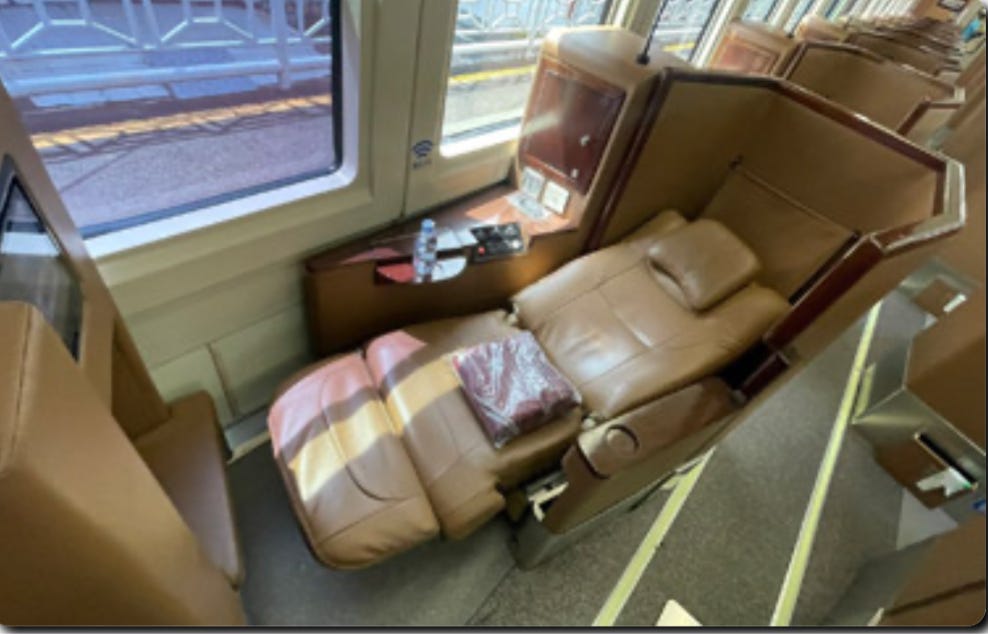
Unfortunately, the agent said this was not being offered. It was unclear whether it was no longer offered on any type of train systemwide, which would surprise me given this was, apparently, a fairly new product. But she indicated it was not available on any train between Jakarta and Yogyakarta the following day. She told me there was a newer version, “Eksekutif Lux,” and seemed to indicate it had replaced what I was looking for — at least on this route. However, this only offered a 1-2 configuration with a bit less of a pod-like experience. So it seemed a bit of a downgrade.
The agent also offered the option of private, one-bed Exexcutif sleeper rooms on an earlier train. Maybe that was the top-end replacement for the pod I was hoping for. But we didn’t want to sequester ourselves in separate rooms on a day train. We wanted an airline Business Class equivalent, not Emirates First Class.
So we went with two “Eksekutif Lux” seats. And we were out of the station — tickets and boarding passes in hand — in no time. I wouldn’t say the tickets were especially cheap. They were around $72 each. That would be a very good deal in Europe or North America for a roughly 300-mile journey. But in Indonesia, it’s more than you might expect.
Train 2: Jakarta to Yogyakarta
Our train to Yogyakarta left at 8:50 AM. We arrived at the station with plenty of time to spare, so were able to spend 20 minutes or so in the “Luxury Lounge” to which our tickets gave us access. It was a pleasant spot with light refreshments and comfortable seats.
We then moved to the platform about 10 minutes before the scheduled departure. After the train pulled in, we figured out which was the Lux carriage, as it was the only one with an elegantly gowned train attendant there to greet passengers.


The seats turned out to be somewhat pod-like. They actually offered more privacy than some airlines’ Business Class. They reclined pretty far back with an extended leg-rest, but not to fully lie-flat. And that was fine. Other than a short post-lunch siesta, I didn’t want to sleep — preferring instead to look outside the window as we traversed the island of Java.




Trains provide a much cleaner way to see a country than cars or buses. Roads require their own unsightly infrastructure and tend to spawn a cluttered sprawl. Trains, by contrast, cut a crisp line through the towns and countryside through which they pass, leaving their surroundings largely undisturbed.
The fast train from Jakarta to Yogyakarta takes about six hours. The route starts on the north side of the island of Java, before cutting inland southeast toward Yogyakarta where the topography becomes more varied.




An iconic sight when traveling by train in Indonesia — and it began on the train from the airport — are the lines of scooters at crossings. Far more people in Indonesia use scooters than cars to get around.

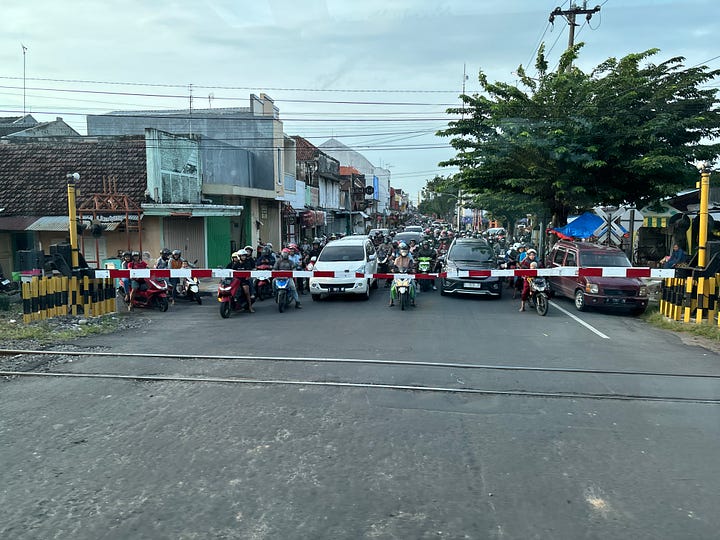
The train attendant brought lunch — chicken and rice — to our seats. We could choose when to have it. The food was fine, and there was more of it than you would usually get on an Economy Class flight. I believe there was a diner car elsewhere on the train for non-Lux passengers wanting to buy lunch.
There was no alcohol. I don’t think that was just a Ramadan thing. But there’s no rule as far as I could tell that you can’t bring your own, and we brought some cans of Bintang we’d picked up on arrival at the Jakarta airport. (By the way, don’t believe stories on the Internet that you can’t buy alcohol on arrival at Jakarta airport. You can, both duty free before passing through customs and, if you missed that, in the arrivals hall and — for beer only — at kiosks just outside. At least, as of March 2024.)
I would certainly advise some discretion when drinking your own alcohol on the train out of courtesy to others, especially during Ramadan. But there was hardly anyone in our carriage and the crew did not bat an eyelid when they saw me putting empty cans in the trash. Besides, the mere fact we were served lunch indicates that non-Moslems are not expected to observe Ramadan fasting on the train.
The train was super clean. I found this applied to all three trains we took in Indonesia. That included the spotless bathrooms.
Yogyakarta sojourn
Coincidentally, my brother was staying in Yogyakarta. And we joined him for two nights at a place called D’Omah Hotel And Village Resort, a charming hotel just outside the city with rooms and villas scattered among lush gardens. Some have their own private pools or jacuzzis. The hotel is at the edge of a village. In fact, a village road runs through part of the hotel property, so it is not one of those places where you feel cut off from local life. The hotel is owned by an Australian who happens to be the Honorary Consul in Yogyakarta for both Mexico and Portugal.




The day after we arrived, we hired a driver to take us to Borobudur and Prambanan temples. Borobudur, dating back to AD 778, is the largest Buddhist temple in the world. Prambanan, going back to around AD 850, is the largest Hindu one in Java.


Train 3: Yogyakarta to Surabaya
Our third train took us back toward the north side of the island and further over to the east as we headed from Yogyakarta to the city of Surabaya.
The ticketing at Yogyakarta was a bit different from how it was at Jakarta. As we were looking for the ticketing window, an agent whose actual job was to check the tickets and boarding passes of people trying to get to their train took us under her wing and made reservations for us on her phone. We then had to go and get cash from an ATM, take the cash to a convenience store just outside the station with a booking code the agent gave us. At the convenience store, we lined up behind people buying snacks, etc., and, when we got to the front, we handed over our money and were then given a print-out with a ticket number. We took that back to the agent who guided us to a machine where we entered the number, whereupon the machine printed out our tickets and boarding passes. So it all worked out, though I suspect there must also be an option of just going to a ticket counter and paying with a credit card as we had in Jakarta.
This time, the choice of seats was different. The Lux pods were not available, but instead we were offered something called Panoramic. As the name suggests, this class — the best available on this route and I imagine a further subset of Eksekutif — offers huge windows and skylights. The two-abreast seating was comfortable, but only offered standard recline.
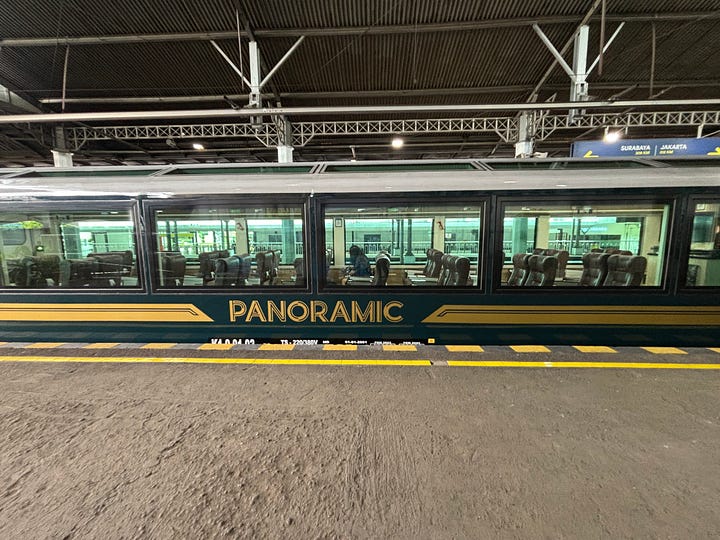

The windows were great for taking in the passing countryside. But the scenery was generally flatter than what we saw from the previous train, which isn’t what I was expecting. If you could only do one of the routes by train, I would go with Jakarta to Yogyakarta.
As on the Lux train, our Panoramic tickets also included lunch brought to our seats. The train attendants on this route had less fancy uniforms, but were equally helpful and friendly.
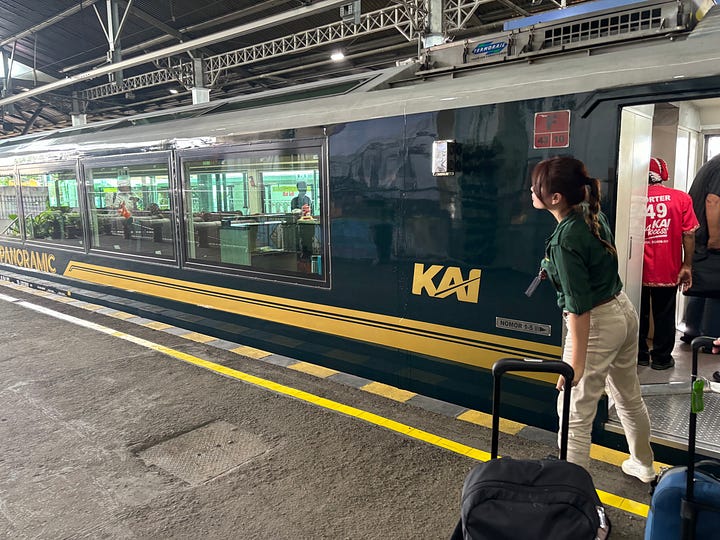

Surabaya’s aviation past
Surabaya is the second largest city on Java. Aside from Jakarta, it is the only one with international flights.
In the early days of international aviation, Surabaya featured more prominently on route maps than it does now. It used to be a stop on the flying boat services operated by Imperial Airways — a forefather of British Airways — and Qantas connecting the UK with Australia. And Amelia Earhart landed there in 1937 as part of her attempted circumnavigation of the world, less than a week before her plane vanished in the Pacific.

Our visit to Surabaya was brief, but we stayed for a night in an old-world hotel, the Majaphit, which evoked Surabaya’s past. The hotel was founded by a scion of the Sarkies family, an Iranian family that developed a hospitality empire in South East Asia at the end of the 19th century: they opened the Eastern & Oriental Hotel in 1880 in Penang, Malaysia, the Raffles Hotel in 1887 in Singapore, and the Strand in Rangoon in 1901. I have stayed in all three of those. Raffles became by far the most famous. The Majaphit, originally named the Oranje, was opened in 1910. But unlike Raffles, which has been “upgraded” to modern-day luxury, the Majaphit remains somewhat more intact — in other words, not as modernized as you might expect, but all the more charming as a result and quite well priced.
We left the country from Surabaya, non-revving on Cathay Pacific to Hong Kong, where we stopped for 36 hours before continuing our circumnavigation of the globe back to the United States. ✈️




